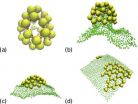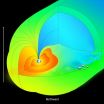(Press-News.org) "In our current paper we present new computational results that explore how membranes may influence crucial biological processes", explains Richard Matthews, Lise-Meitner-Fellow at the University of Vienna and first author of the study. The focus of the investigation is the self-assembly of microscopic particles, the formation of structures or patterns without human intervention. More specifically, the effect of the interactions between membranes and proteins, which can influence the formation of ordered structures in cells, is considered.
Self-assembly has become a hot topic in recent years. Many of the most astonishing examples are found in nature, from tiny motors (e.g. the flagellum motor) to virus capsids with perfect spherical forms. Many researchers have also tried to improve our understanding by representing the assembly of such structures with models. In order to gain clear insight it is preferable that these models are as simple as possible. This approach has been very successful in reproducing key features of experiments, whilst also uncovering new aspects. In reality, these processes do not occur in isolation and, in fact, many happen on, or in the vicinity of, membranes, a fact that has been previously neglected in the construction of simple models.
Advanced Simulation Techniques
The research aims to find out the general properties of these fascinating systems by applying state of the art simulation techniques. This requires everything to be calculated on a computer. Due to the complexity of the task, high performance computers are necessary. "In our work we have applied advanced simulation techniques, which allowed us to see how interactions with a membrane influence self-assembly", explains Richard Matthews. "We determined that membranes promote self-assembly and also find that our model reproduces structures that are very similar to those seen in nature."
INFORMATION:
Publication:
Influence of Fluctuating Membranes on Self-Assembly of Patchy Colloids. Richard Matthews and Christos N. Likos. Physical Review Letters. October 2012.
DOI: 10.1103/PhysRevLett.109.178302
Scientific Contacts:
Richard James Matthews
Computational Physics
University of Vienna
1090 Vienna, Sensengasse 8
T +43-1-4277-732 33
richard.matthews@univie.ac.at
Christos N. Likos
Computational Physics
University of Vienna
1090 Vienna, Sensengasse 8
T +43-1-4277-732 30
T +43-1-4277-732 31
christos.likos@univie.ac.at
Press Contact:
Veronika Schallhart
Press office
Research and teaching
University of Vienna
1010 Vienna, Universitätsring 1
T +43-1-4277-175 30
M +43-664-602 77-175 30
veronika.schallhart@univie.ac.at
New insights into membrane-assisted self-assembly
2012-10-24
ELSE PRESS RELEASES FROM THIS DATE:
Study: Flame retardant 'Firemaster 550' is an endocrine disruptor
2012-10-24
The flame-retardant mixture known as "Firemaster 550" is an endocrine disruptor that causes extreme weight gain, early onset of puberty and cardiovascular health effects in lab animals, according to a new study spearheaded by researchers from North Carolina State University and Duke University.
Firemaster 550 is made up of four principal component chemicals and is used in polyurethane foam in a wide variety of products, ranging from mattresses to infant nursing pillows. The flame-retardant mixture was developed by Chemtura Corp., and was first identified by the research ...
Voice prostheses can help patients regain their lost voice
2012-10-24
Help is on the way for people who suffer from vocal cord dysfunction. Researchers are developing methods that will contribute to manufacturing voice prostheses with improved affective features. For example, for little girls who have lost their voices, the improved artificial voice devices can produce age-appropriate voices, instead of the usual voice of an adult male. These advances in artificial voice production have been made possible by results achieved in a research project led by Professor Samuli Siltanen, results that are good news indeed for the approximately 30,000 ...
Unearthing a hidden dietary behavior
2012-10-24
Though it was identified as a disorder as early as the 14th century, pica, or the eating of non-food items, has for years believed to be all but non-existent in a few corners of the globe – a 2006 study that reviewed research on pica found just four regions – the South of South America, Japan, Korea and Madagascar –where the behavior had never been observed.
A new Harvard study, however, is showing that pica – and particularly geophagy, or the eating of soil or clay, is far more prevalent in Madagascar, and may be more prevalent worldwide, than researchers previously ...
Hypnosis helps hot flashes
2012-10-24
CLEVELAND, Ohio (October 24, 2012)—Hypnosis can help cut hot flashes by as much as 74%, shows a study supported by the National Center for Complementary and Alternative Medicine. This is the first controlled, randomized study of the technique to manage hot flashes, which affect as much as 80% of women who go through menopause. The study was published online this month in Menopause, the journal of the North American Menopause Society.
Controlled, randomized studies may pit an active drug against an inactive placebo pill. But it's hard to find a placebo for mind-body techniques. ...
Brainwave training boosts network for cognitive control and affects mind-wandering
2012-10-24
A breakthrough study conducted in Canada has found that training of the well-known brainwave in humans, the alpha rhythm, enhances a brain network responsible for cognitive-control. The training technique, termed neurofeedback, is being considered as a promising new method for restoring brain function in mental disorders. Using several neuroimaging methods, a team of researchers at the Western University and the Lawson Health Research Institute have now uncovered that functional changes within a key brain network occur directly after a 30-minute session of noninvasive, ...
Earth's magnetosphere behaves like a sieve
2012-10-24
ESA's quartet of satellites studying Earth's magnetosphere, Cluster, has discovered that our protective magnetic bubble lets the solar wind in under a wider range of conditions than previously believed.
Earth's magnetic field is our planet's first line of defence against the bombardment of the solar wind. This stream of plasma is launched by the Sun and travels across the Solar System, carrying its own magnetic field with it.
Depending on how the solar wind's interplanetary magnetic field – IMF – is aligned with Earth's magnetic field, different phenomena can arise ...
An eye for an eye, a tooth for a tooth
2012-10-24
This press release is available in German.
It all began with a harmless game of soccer among young men in northwestern Albania. After one of the players had been injured in a subsequent dispute, his team members shot a relative of the suspected attacker. Now the male members of the families involved in the blood feud do not dare leave their homes. Such vendettas and blood feuds occur in many societies, sometimes lasting for decades. The harm for the participants is enormous and lacks apparent benefit, as the participants often no longer remember what actually triggered ...
Lactation protein suppresses tumors and metastasis in breast cancer
2012-10-24
BUFFALO, N.Y. -- A protein that is necessary for lactation in mammals inhibits the critical cellular transition that is an early indicator of breast cancer and metastasis, according to research conducted at the University at Buffalo and Princeton University and highlighted as the cover paper in November issue of Nature Cell Biology.
"This is the first confirmed report that this protein, called Elf5, is a tumor suppressor in breast cancer," explains Satrajit Sinha, PhD, associate professor of biochemistry in the UB School of Medicine and Biomedical Sciences and a corresponding ...
Hot flashes can come back after SSRI
2012-10-24
CLEVELAND, Ohio (October 24, 2012)—Hot flashes and night sweats can return after women stop using escitalopram—an antidepressant—to treat these menopause symptoms, according to a study published online this month in Menopause, the journal of the North American Menopause Society. This is typical of stopping hormone therapy as well.
Not every woman who took escitalopram in this National Institutes of Health-supported study had her symptoms come back, however. Symptoms returned for only about one third of the women. These women were more likely than others to have had insomnia, ...
Expert advisory: VCU study finds simple prevention strategy reducing MRSA infections
2012-10-24
RICHMOND, Va. (Oct. 24, 2012) – High compliance with hand hygiene and focusing on other simple infection control measures on medical, surgical and neuroscience intensive care units resulted in reduced rates of methicillin-resistant Staphylococcus aureus (MRSA) infection by 95 percent in a nine-year study, according to research findings by Virginia Commonwealth University physicians presented during IDWeek 2012.
Most hospitals use vertical infection prevention strategies, which focus on culturing for patients harboring organisms such as MRSA and isolating those patients. ...

